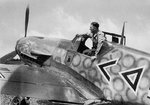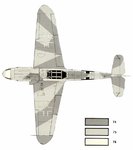kingstonian
Airman
Zvezda Bf 109 F2 calls for two tone grays....
however I am almost sure that this was applied November 1941,
so an aircraft operated in June July means that was painted and delivered even earlier.
in particular I am thinking of modelling eirther the "green heart" or the Hahn aircraft ie the circled pattern.
my impression is that it was not even a 70-71 pattern, more like a 71-02 over 65.....
Am I correct in any way or indeed a 74/75/76 could be the case?
thanks
however I am almost sure that this was applied November 1941,
so an aircraft operated in June July means that was painted and delivered even earlier.
in particular I am thinking of modelling eirther the "green heart" or the Hahn aircraft ie the circled pattern.
my impression is that it was not even a 70-71 pattern, more like a 71-02 over 65.....
Am I correct in any way or indeed a 74/75/76 could be the case?
thanks









